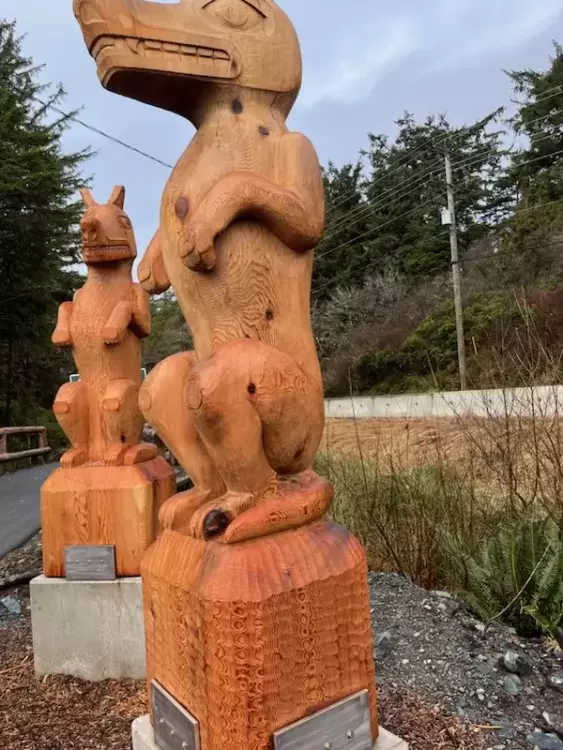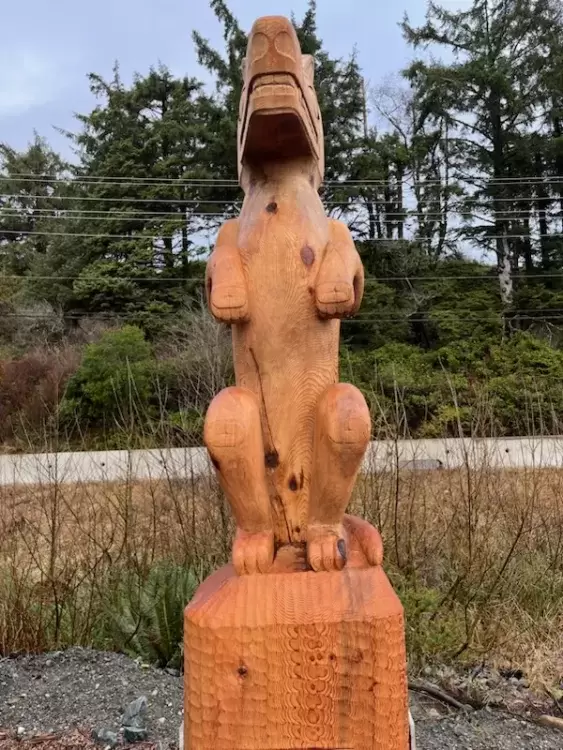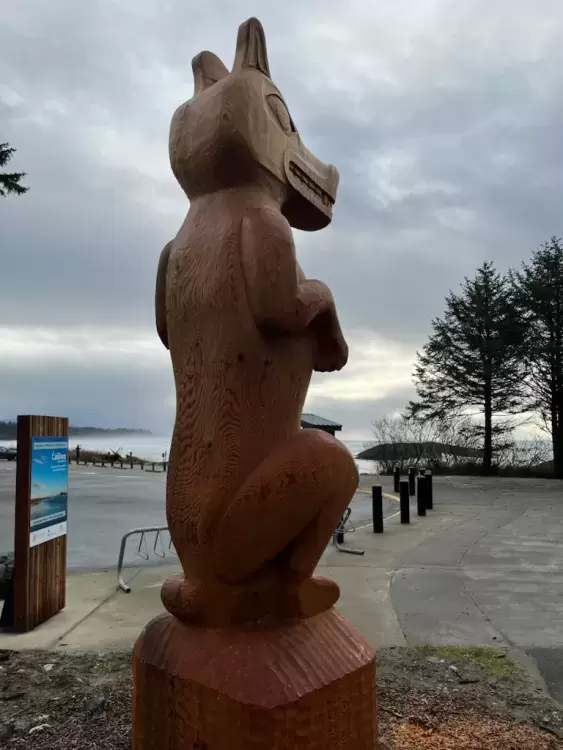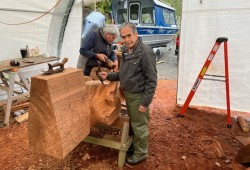Visitors to Pacific Rim National Park’s Long Beach near Tofino will now have access to Nuu-chah-nulth art and culture, thanks to a new trail that celebrates history and teachings of local First Nations. The trail, named ʔapsčiik t̓ašii, is located in the haḥuułi of the Tla-o-qui-aht First Nation and Yuułuʔiłʔatḥ.
ʔapsčiik t̓ašii, pronounced ‘ups-cheek ta-shee’, is a 25-kilometre multi-use pathway through the Long Beach unit of Pacific Rim National Park Reserve. It can be seen on the west side of Highway 4 heading to Tofino.
According to Richard Giele, the national park’s visitor experience manager, Parks Canada worked with both First Nations to involve local communities and ensure the pathway presents a cultural experience for visitors.
“Parks Canada is committed to a national network of heritage places that celebrates the contributions of First Nations peoples, their histories and cultures, as well as the special relationship First Nations peoples have with lands and waters,” said Giele in an email to Ha-Shilth-Sa.
The paved path will include art installations commissioned by Parks Canada that are created by artists from each nation.
For Tla-o-qui-aht, a pair of beautifully carved red cedar wolf figures overlook the ocean at the Long Beach parking lot. The figures were carved over the summer of 2022 by Tla-o-qui-aht master carver Joe Martin and can be seen from the highway nearing the Tla-o-qui-aht community of Esowista.
According to Giele, decisions on the name of the path and the art installations were made on the advice of an elder’s working group struck by each First Nation.
“The name of the pathway, ʔapsčiik t̓ašii, means ‘going in the right direction on the path’. Chosen from the local Indigenous languages, it speaks to the future direction, the path forward, and travelling it together as partners,” Geile wrote.
He went on to say that both Tla-o-qui-aht First Nation and Yuułuʔiłʔatḥ conducted site visits to choose the location for their own commemoration piece.
“The Tla-o-qui-aht chose the location C̓ašiiwa, Incinerator, meaning ‘The Voice of the Ocean’,” said Giele.
The Tla-o-qui-aht, in collaboration with Parks Canada, agreed on the theme of wolves for their location.
“Wolves are highly revered in ƛaʔuukʷiʔatḥ First Nation territory. The wolves that live here are integral to the health of these ecosystems. Their presence shapes and protects the forests and waterways, keeping nature in balance and strengthening biodiversity,” Giele stated.
He went on to say that wolves are also spiritual protection of the traditional leaders and the citizens of the ƛaʔuukʷiʔatḥ (Tla-o-qui-aht) Nation.
“The significance of the name wolf, Qʷayac̓iik, describes and means the ‘Way We Must Be - To Uphold Our Responsibilities and Make Things Right As We Travel Through Life. Go the Right Way and Speak Truthfully’,” explained Giele.
Carved from red cedar, the pair of wolves is meaningful for Martin.
“Our art is a way of teaching that is different from the mamulthni (Caucasian) culture,” said Martin. “In our culture, teaching starts in the womb.”
Martin explained that it was mainly the elders that did the teaching, ha-hopa.
“There were teachings in the murals on the houses and on the poles, the ancestors would teach that way – for our people, art was a way of educating,” said Martin.
He explained his people were illiterate at the time of first contact with Europeans.
“We were not able to read their written words but so were they…they were not able to read our history in our art,” said Martin. “These figures have meaning.”
He went on to say that when art and regalia were taken away to be put in museums and residential schools were introduced, learning became different.
“We have a lot of social problems today – something is missing,” said Martin. “When children are brought up respectfully, discipline comes naturally.”
Martin explained that Quu-as (traditional) names had meaning, and each name came with a responsibility. Elders, he explained, would sit with the children to teach them about that.
He recalled spending time with his own father as a young boy.
“Dad never left me choice to go hunting, fishing, trapping – it was ‘let’s go’, and we went,” he recalled.
The elder Martin would bring his sons along to watch him make canoes – never pressuring them to learn.
“I watched him adzing a log, then, one day I went to him and asked him to show me how to do it,” Martin recalled.
His father demonstrated how to use the adze and told his son to get a lot of practice.
“People don’t know how to work with their hands anymore,” said Martin.
Parks Canada is doing its part to revive these cultural teachings. They commissioned the carvings for approximately $50,000.
They are working with Yuułuʔiłʔatḥ, who are currently developing their commemoration carving for ʔapsčiik t̓ašii.
In addition to this project, Parks Canada is working with other Nuu-chah-nulth nations on projects through the Stories of Canada program.
“First Nations who have haḥuułi along the West Coast Trail received funding to share their stories in the way they wished (i.e., in their own voices, and their own way),” Giele shared.
At Pacific Rim National Park Reserve, the nations call the program the “honouring haḥuułi” where each First Nation developed their own project.
“Ditidaht First Nation developed nine interpretive panels sharing their history, village locations, and names, which are expected to be installed this year,” said Giele.
In addition, Pacheedaht First Nation developed four panels, and the Huu-ay-aht First Nations carved replicas of two welcome figures and installed them in September at Kiixin National Historic Site, located approximately 5 kilometres from the West Coast Trail.
While Martin has finished his portion of the project, he continues to produce more art.
“Now I am carving a wolf, bear and female welcome figures,” said Martin.
He says at least one of the figures will stand in Ha’uukmin Tribal Park in Tla-o-qui-aht territory.





